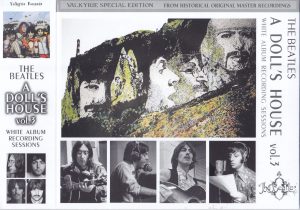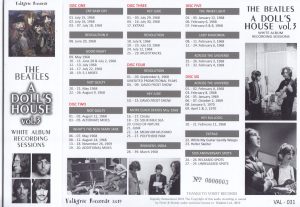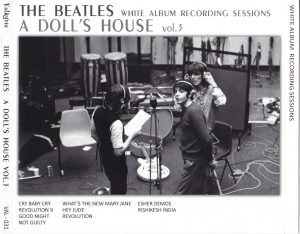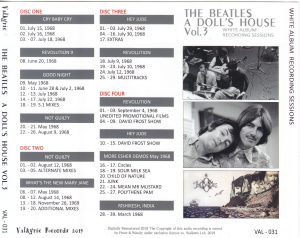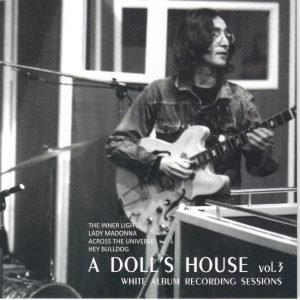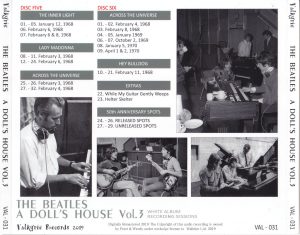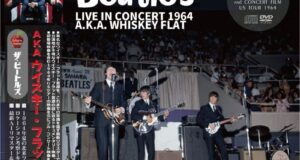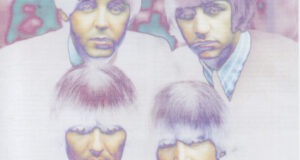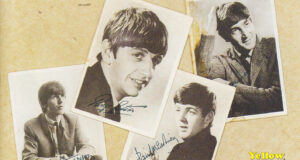Beatles / A Dolls House Vol 3 / 6CD With Slipcase / Valkyrie Records
White Album Recording Sessions VOL 3 Digitally Remastered
Click Image To Enlarge
The Beatles, who pulled out of all the live activities and focused on studio work, first released “Sargent Peppers”. Produced with a variety of sound effects, this album has a very lively atmosphere. Not only the music but also the album and jacket are elaborate, and the times can not keep up with the evolution and change of the Beatles, and the public drew controversy over the interpretation of this album. LSD etc. will be the best of the deep reading. It was Paul who led such a flashy “Sargent Peppers”. If John led the band as a leader in the early Beatles, Paul caught up with rubber souls and revolvers, and in ‘Sargent Peppers’ it’s clear that at least the musical initiative has shifted to Paul . The words “Sargent Peppers” appear in the lyrics at the beginning of “How Do You Sleep?” That beat Paul from the album “Imagine”, but John himself acknowledged that Paul was leading the band at this time. It is The band leader’s transition from John to Paul has a subtle effect on the relationships among the members of the Beatles who boast a solid unity, and it seems that the foundation for breaking up began from around this time.
The next album of Sargent Peppers reflecting this psychedelic era is The Beatles, commonly known as a white album. The Beatles set up Apple Records for the first time with its own label. He also stayed in India to ask Maharishi’s teachings for philosophical meaning, and most of the songs recorded on the white album were written when he was in India. This stay in India is from February to April 1968. And as early as May after returning to the UK, all the members gathered at George’s home to do a demo recording. The sound source at this time is called an Esher demo. Based on this demo sound source, full-scale recording starts in June. The White Album is the Beatles’ first double album. The album jacket is more simple, with only the white band embossed and white banded and numbered, as if it were a reaction to the gorgeous previous work “Surgent Peppers”. The album title itself is simply “THE BEATLES” whereas the previous work was a fictional long band name. The “White Album” was released in November 1968, in contrast to the previous work, and has achieved great sales success.
It was mentioned earlier that the transfer of musical leadership from John to Paul was the foundation of the Beatles dissolution, but in fact, at this time, Apple did not boycott recording and did not come to the studio, or the recording was not always carried out by four people. It’s not like that, and it seems like the episode of “White Album” seems like the sprouting of dissolution breaks up. As a part of it, when criticizing this album, it is argued that this is not a band’s album but a collection of solo songs. I see, that is not a mistake. The fact that it became a salesally disadvantageous double album in the first place is the result of each member refusing to neglect his own song despite the suggestion by George Martin to condense the contents into a single album Some say that. Paul did not seek to hide his aversion to “Revolution 9”, but where there was no opinion rejecting the recording, a glimpse of the unstable balance of human relationships in a subtle band. However, even in such a situation, there will be no objection to the wonder of “White Album”. Many of the fans actually like this album the most. Paul says this in an interview: “It is said that this album has no context or is a collection of solo songs, but it’s the Beatles white album. It’s shut up!”
This work has recorded the session sound source of this white album. It will be an unprecedented monumental one with a large number of first appearance sound sources, with unprecedented volume. There have been many titles that have recorded a large number of white album session sound sources, but this work not only covers already existing sound sources, but also includes many first appearance sound sources that no one has ever listened to There is. And since the original is a double album, it actually goes up to 18 discs as a session sound source of a white album. This set is divided into Vol.1, Vol.2, Vol.3 and 6 sets 3 sets and it will be released. This work is its Vol.3.
ライブ活動の一切から手を引き、スタジオ・ワークに専念したビートルズが最初にリリースしたのが『サージェントペパーズ』であった。煌びやかで様々な効果音を駆使して制作されたこのアルバムは、非常に賑やかな雰囲気を持っている。楽曲もさることながら、アルバム・ジャケットも凝ったもので、ビートルズの進化と変化に時代が追い付かず、世間ではこのアルバムの解釈を巡って議論を呼んだ。LSDなどはその深読みの最たるものであろう。このような派手な『サージェントペパーズ』を主導したのはポールであった。初期ビートルズではジョンがリーダーとしてバンドを牽引していたとしたら、ラバーソウルやリボルバー当たりでポールが追い付き、そして『サージェントペパーズ』では明らかに、少なくとも音楽的主導権はポールに移行しているのは明白だ。アルバム『イマジン』収録のポールを揶揄する「How Do You Sleep?」の冒頭の歌詞で「サージェントペパーズ」が登場するのも、この時期ポールがバンドを主導していたことを事実上ジョン自身が認めたものである。このようなバンド・リーダーのジョンからポールへの移行は、盤石な結束を誇ったビートルズのメンバーの人間関係に微妙な影響を及ぼし、解散への布石はこの頃から始まったと思われる。
このようなサイケデリック時代を反映させた『サージェントペパーズ』の次のアルバムが、通称ホワイトアルバムと呼ばれる『ザ・ビートルズ』である。この時期のビートルズはアップル・レコードを設立し、初めて自社レーベルがリリースされることになる。また哲学的な意味を求めてマハリシの教えを請うためインドに滞在しており、ホワイト・アルバム収録曲の大半は、このインド滞在時に書かれたものである。このインド滞在期間は1968年2月から4月にかけて。そして英国に帰国後の5月に早くもメンバー全員がジョージの自宅に集まりデモ録音を行なっている。この時の音源がイーシャー・デモと呼ばれるものである。このデモ音源を元に、本格的なレコーディングが始まるのは6月になってからの事である。 ホワイト・アルバムはビートルズ初のダブル・アルバムである。華美な前作『サージェント・ペパーズ』の反動でもあるかのように、アルバム・ジャケットは白一色にエンボス加工でバンド名が記され、ナンバリングがなされているのみの、これ以上なシンプルなものである。アルバム・タイトル自体も、前作が架空の長いバンド名だったのに対し、シンプルに『THE BEATLES』である。かように前作とは対比的な『ホワイト・アルバム』は1968年11月にリリースされ、セールス的にも大成功を収めている。
ジョンからポールへの音楽的主導権の移行がビートルズ解散の布石であったと先述したが、実際にこの時期、リンゴがレコーディングをボイコットしてスタジオに来なかったり、レコーディングは必ずしも4人揃って行なわれたものでなかったりと、解散の萌芽が肥大化していく様は『ホワイト・アルバム』時のエピソードのそこかしこに感じられる。その一端として、このアルバムを批判する際に、これはバンドのアルバムではなくソロ曲の寄せ集めだという意見がなされる。なるほど、それはある意味間違いではない。そもそもセールス的に不利なダブル・アルバムになったのも、ジョージ・マーティンが内容を凝縮してシングル・アルバムにしようと提案したにもかかわらず、メンバーそれぞれが自分の曲を割愛する事を拒否した結果だという話もある。ポールは「レボリューション9」に対し嫌悪感を隠そうとせず、しかし収録を拒否する意見が通らなかったところに、微妙なバンド内の人間関係のバランスの不安定さが垣間見れる。しかし、そのような状態であっても、『ホワイト・アルバム』の素晴らしさに異論はないだろう。実際にファンの間ではこのアルバムが最も好きだという人も多い。ポールはインタビューでこのように発言している。「このアルバムは脈絡がないだとか、ソロの曲の寄せ集めだとか言われるが、ビートルズのホワイト・アルバムだぞ。黙れってんだ!」。
本作は、このホワイト・アルバムのセッション音源を収録している。従来にないボリュームで、初登場音源を多数含むこれ以上ない記念碑的なものとなるであろう。これまでも数多くホワイト・アルバムのセッション音源を収録したタイトルは数多く存在したが、本作は既発音源を網羅したのみならず、今まで誰も聴いたことがない数多くの初登場音源を含んでいる。しかも元がダブル・アルバムなだけに、実にホワイト・アルバムのセッション音源としてディスク18枚分にも上る。今回のセットはVol.1、Vol.2、Vol.3と、それぞれ6枚組3セットに分割してリリースされることとなった。本作はそのVol.3である。
DISC ONE
CRY BABY CRY
July 15, 1968
01. Version One Rehearsal
July 16, 1968
02. Take 1
July 18, 1968
TAKE 12 (5.1 MIXES)
03. Basic Track
04. No harmonium mix
05. Harmonium, extra vocals
06. Extra John vocal
07. Bass SI 1
REVOLUTION 9
June 20, 1968
08. RM Acetate Alternate Mix
GOOD NIGHT
May 1968
09. Demo (Two Virgins Recording)
June 28 & July 2, 1968
10. Take 7
11. Take 10
UNUSED SESSION
July 1968
12. Intro unknown take 1
13. Intro unknown take 2
July 22, 1968
14. Take 22
15. Takes 22 & 34 edit
16. Take 34 RM6
17. Advance Acetate Rough Mix
5.1 MIXES
18. Vocal
19. Orchestra
NOT GUILTY
May 1968
20. Demo
21. Demo Tape copying
August 9, 1968
22. Take 99 reduction = 102 SI
23. Take 102 SI
24. Take 102 isolated overdubs
25. Take 102 complete
26. Monitor Mix
DISC TWO
NOT GUILTY
August 12, 1968
01. RM1
02. Acetate Mix
ALTERNATE MIXES
03. Stereo John Barrett
04. Stereo Roger Scott
05. Stereo George Martin
WHAT’S THE NEW MARY JANE
May 1968
06. Demo
07. Demo Tape copying
August 14, 1968
08. Take 1
09. Take 2 announcement
10. Overdub chat (partial)
11. Take 4 complete (Roger Scott)
12. Take 4 edit (John Barrett)
November 26, 1969
13. RS4
14. RS5
15. RS6
16. Review Acetate side One
17. Review Acetate side Two
18. Unreleased Single Edit
ADDITIONAL MIXES
19. RS Take 4 Sessions edit
20. RS Take 4 Anthology edit
DISC THREE
HEY JUDE
July 29, 1968
01. Take 1
02. When I was a Robber
03. Take 2
July 30, 1968
(No actual Take 7 available)
04. Take 8 (partial)
05. Take 9
06. Take 10 (breakdown)
07. St. Louis Blues #1
08. Take 11 (breakdown)
09. Take 12 (breakdown)
10. Lady Madonna/Take 13 (breakdown)
11. Take 14
12. Las Vegas Tune
13. Take 15 (breakdown)
14. Take 16 (partial)
15. St. Louis Blues #2
16. Take 23
EXTRAS
17. Take 9 edit (John Barrett/Abbey Road Show)
REVOLUTION
July 9, 1968
18. Rehearsal
July 10, 1968
19. Unknown Take fragment
20. Take 9 (mislabeled as ‘14’)
21. Take 10 w/SI
22. Vocals SI (multitrack)
23. Take 15 Rough Mix
July 12, 1968
24. Take 16
MULTITRACKS
25. Drums
26. Bass SI
27. Guitars Track 1
28. Guitars Track 2 & Piano
29. Instrumental
DISC FOUR
September 4, 1968
UNEDITED PROMOTIONAL FILMS
REVOLUTION
01. Warming up – It’s Now or Never
02. Take 1
03. Take 2
DAVID FROST SHOW
04. Warming Up
05. Take 1
06. False Start
07. Take 2/It’s Now or Never
08. Rehearsal
09. Take 3/You’re my Sunshine
HEY JUDE
10. Warming Up
11. Take 1
12. In the Middle of an Island – Banana Boat Song
13. Take 2
14. Get Back?
15. Take 3
ESHER DEMOS May 1968
CIRCLES
16. Demo
17. Demo Tape copying w/overdub
SOUR MILK SEA
18. Acoustic Demo
19. Electric Demo
CHILD OF NATURE
20. Demo
JUNK
21. Demo
MEAN MR MUSTARD
22. Demo 1
23. Demo 2 overdubs
24. Double tracked demo
POLYTHENE PAM
25. Demo 1
26. Demo 2 overdubs
27. Double tracked demo
March 1968, RISHIKESH, INDIA
28. The Saints
29. You Are My Sunshine
30. Jingle Bells
31. She’ll Be Comin’ Around The Mountain
32. Happiness Runs w/Donovan
33. Instrumental w/Donovan
34. Blowin’ In The Wind
35. Hare Krishna Mantra
36. O Sole Mio
37. Catch The Wind
38. Spiritual Regeneration
39. Happy Birthday Mike Love
DISC FIVE
EARLY 1968 SESSIONS
THE INNER LIGHT
January 12, 1968
01. Take 2 (breakdown)
02. Take 3
03. Take 4 (breakdown)
04. Take 5
05. Take 8? Announcement
February 6, 1968
06. Copying Take 5 into Take 6
February 6 & 8, 1968
07. Vocal and Backing SI
LADY MADONNA
February 3, 1968
08. Take 2
09. Take 3 with vocal SI
10. Overdubs onto Take 3 (isolated)
11. Overdubs onto Take 3
February 6, 1968
12. Take 4
13. Take 4 Vocal SI isolated
14. Take 4 Monitor Mix #1
15. Take 4 Monitor Mix #2
16. Take 4 Monitor Mix #3
17. Take 4 Monitor Mix #4
18. Take 5 SI (isolated) (5.1)
19. Take 5 Brass SI (5.1)
20. Take 5 Backing vocals SI (5.1)
21. Takes 4 & 5 tape copying
22. RS1
23. Takes 3, 4 & 5 mix
24. Take 5 alternate mix (5.1)
ACROSS THE UNIVERSE
February 3, 1968
25. Take 2 monitor mix
26. Take 2
February 4, 1968
27. Take 6
28. Take 7
29. Take 7 tamboura SI
30. Take 7 ‘naked mix’
31. Take 7 female vocals SI
32. Take 8 RS Acetate
DISC SIX
ACROSS THE UNIVERSE
February 4, 1968
01. Take 8 RM1 Rough Mix‘Hums Wild’
02. Hums Wild Lost Lennon Tapes version
February 8, 1968
03. SI onto Take 8
January 1969
04. RM2 w/SFX
05. RM2 acetate playback
October 2, 1969
06. RS2 GM WWF Speed corrected
07. RM GM WWF Acetate
January 5, 1970
08. RS3 Glyn Johns Mix
April 1 & 2, 1970
09. RS13 Take 9 PS Mix speed corrected
HEY BULLDOG
February 11, 1968
10. Take 2 intro chat
11. Unknown take breakdown
12. Take 10
13. Take 10 w/SI (multitrack)
14. Bass SI & original (multitrack)
15. Vocal session fragment
16. Vocals SI (multitrack)
17. Extra John Vocal SI (5.1. mix)
18. Bass SI and drum SI (5.1 mix)
19. Take 10 RS
20. Take 10 RM2
21. Original Film Mono Mix
EXTRAS
WHILE MY GUITAR GENTLY WEEPS
22. Instrumental w/Paul rough vocal
HELTER SKELTER
23. Instrumental
50th ANNIVERSARY RELEASED SPOTS
24. Out Now 30”
25. Holiday Gift 30”
26. Xmas Gift 30”
50th ANNIVERSARY UNRELEASED SPOTS
27. This is The Beatles 15”
28. This is The Beatles 20″
29. This is The Beatles 30”
 GiGinJapan Artwork of Japanese CDs (mostly)
GiGinJapan Artwork of Japanese CDs (mostly) 